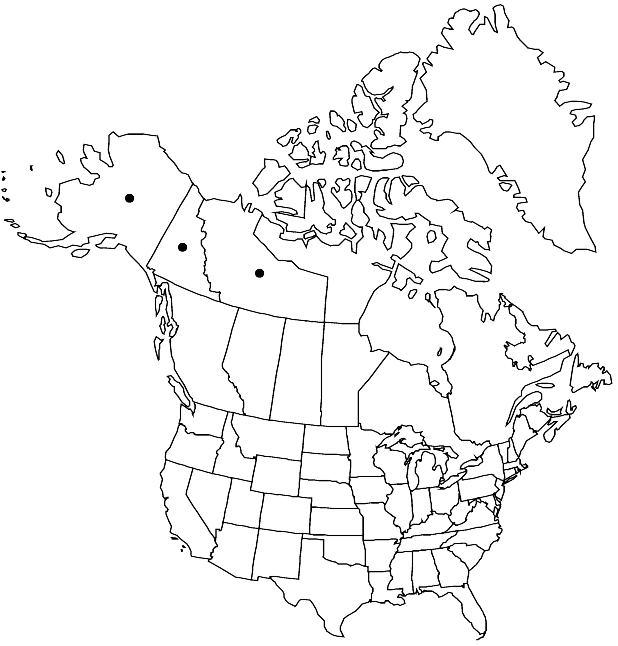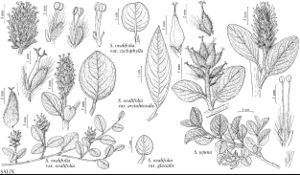Salix ovalifolia
Nouv. Mém. Soc. Imp. Naturalistes Moscou 2: 306, plate 13. 1832.
Plants 0.02–0.05 m, not clonal or forming clones by layering. Stems trailing; branches yellow-brown, gray-brown, or red-brown, glabrous or hairy; branchlets yellow-green, yellow-brown, or red-brown, glabrous or pilose. Leaves: stipules usually absent or rudimentary, rarely foliaceous; petiole (deeply to shallowly grooved adaxially), 1.1–16 mm, (glabrous); largest medial blade hypostomatous, narrowly to broadly elliptic, circular, subcircular, or obovate, 13–46 × 7–20 mm, 1–3.4 times as long as wide, base subcordate, cordate, rounded, or convex, margins slightly revolute or flat, entire, sometimes ciliate, apex convex, rounded, acuminate, acute, or retuse, abaxial surface glabrous, villous, long-silky, pubescent, or pilose, hairs wavy or straight, adaxial highly glossy, usually glabrous; proximal blade margins entire; juvenile blade (reddish or yellowish green), pilose, villous, or long-silky abaxially. Catkins: staminate 4.8–46 × 5–11 mm, flowering branchlet 1.5–24 mm; pistillate moderately densely flowered, stout, subglobose, globose, or slender, 6.3–50 × 5–28 mm, flowering branchlet 2.5–22 mm; floral bract brown, greenish, or bicolor, 1.2–2 mm, apex rounded, entire or, sometimes, 2-fid, abaxially hairy, hairs straight or wavy. Staminate flowers: abaxial nectary 0.6–1 mm, adaxial nectary oblong or ovate, 0.6–1.6 mm, nectaries distinct or connate and cup-shaped; filaments distinct or connate less than 1/2 their lengths (glabrous); anthers elliptic, short-cylindrical, or globose, 0.3–0.5(–0.6) mm. Pistillate flowers: abaxial nectary (0–)0.4–0.6 mm, adaxial nectary longer than stipe; stipe 0.2–1.4 mm; ovary obclavate or pyriform, glaucous or not, usually glabrous or tomentose, sometimes pubescent or villous, beak abruptly tapering to styles; ovules 10–15 per ovary; styles 0.2–0.8 mm; stigmas flat, abaxially non-papillate with pointed tip, or slenderly cylindrical, 0.32–0.41–0.64 mm. Capsules 5.2–9.6 mm. 2n = 38.
Distribution

N.W.T., Yukon, Alaska, Asia.
Discussion
Varieties 4 (4 in the flora).
The varieties of Salix ovalifolia are relatively minor variants; their ranges overlap and their differences in leaf shape and ovary indumentum intergrade (G. W. Argus 1969, 1973). The only one with a more or less distinctive geographical distribution is var. cyclophylla; where its range overlaps with var. ovalifolia there is intergradation. Variety arctolitoralis, which is characterized by larger leaves and catkins, may be an ecotype. Variety glacialis is known only from near Point Barrow, Alaska. E. Hultén (1968) suggested, probably based on its often tomentose ovaries, that it is S. arctica × S. ovalifolia. All varieties of the species have some plants with hairy ovaries, but the suggestion that this character is an indication of hybridization deserves study.
Hybrids:
Salix ovalifolia forms natural hybrids with S. arctica and S. fuscescens.
Selected References
None.
Lower Taxa
Key
| 1 | Ovaries usually tomentose, sometimes glabrous; largest medial blades 8.5-14 mm; endemic to Point Barrow, Alaska. | Salix ovalifolia var. glacialis |
| 1 | Ovaries usually glabrous, sometimes pubescent or villous; largest medial blades 13-46 mm; not endemic to Point Barrow, Alaska | > 2 |
| 2 | Largest medial blades subcircular to circular, 1-1.5 times as long as wide. | Salix ovalifolia var. cyclophylla |
| 2 | Largest medial blades narrowly to broadly elliptic, obovate, or subcircular, 1.1-3.4 times as long as wide | > 3 |
| 3 | Largest medial blades elliptic, broadly elliptic, or subcircular, 13-28 mm. | Salix ovalifolia var. ovalifolia |
| 3 | Largest medial blades narrowly to broadly elliptic or obovate, 25-46 mm. | Salix ovalifolia var. arctolitoralis |
